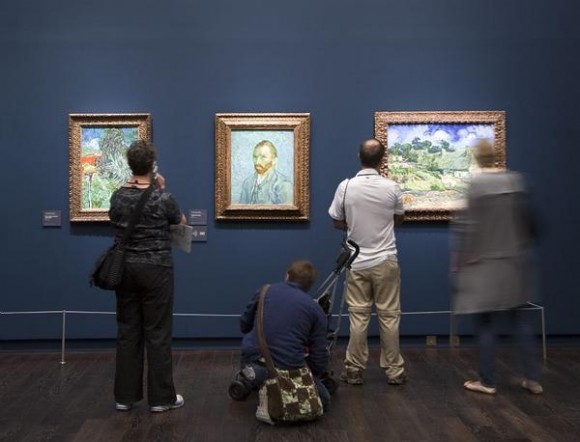
During the last four years of his life, Vincent Van Gogh produced a phenomenal number of works. But it was also the time when he suffered episodes of madness, which were to lead him to suicide in 1890 at the age of 37.
The Orsay museum chose this period of intense creation and of psychological despair to present the current exhibit entitled, “Van Gogh/Artaud. The man driven to suicide by society.” This new approach to the genius of Van Gogh is through the eyes of Antonin Artaud, a poet, actor and artist, who suffered serious mental illness, was interned nine years and underwent shock treatment. In 1947, he had a chance to see a major retrospective of Van Gogh’s works at the Orangerie museum. He wrote, “Van Gogh was not crazy, he was saying a truth that society could not accept.” He went on by denouncing the prejudices of moral and science unable to fit genius and madness within the accepted norms. Throughout the exhibit,the paintings and drawings of Van Gogh are commented in poetic terms by this troubled soul mate.

The exhibit opens in a very dark room, with incoherent sentences scattered on the black walls with a back drop of moaning sounds. Forty six of Van Gogh’s strongest works have been selected along with some graphic works. The visitor travels through four periods of the Dutch painter’s life – in Paris, Arles, Saint-Remy-de-Provence and Auvers-sur-Oise.
Several among the more than 40 self portraitsVan Gogh painted throughout his life are — for the public — like a brutal confrontation with the artist. They certainly are not an exercise in complacency, but a harsh and almost merciless exercise. American art historian Meyer Schapiro remarks that, for Van Gogh, creating a self portrait was a form of therapy and a way to reconstruct his inner self. The artist used it to protect himself from crises of instability.
In contrast, portraits of ” La Berceuse” and “Père Tanguy” express the peaceful and introspective mood of the models. In both paintings, the background — floral in one, Japanese etchings in the other — show his attraction to pure decorative and aesthetic considerations reminiscent of Matisse’s. The portrait of Dr. Gachet, at first his psychiatrist and then his friend, seems to radiate kindness, but also melancholy. Van Gogh writes, “This man is in as bad a shape as myself. He wears the sorry expression of our times.”
After the tragedy of the night of Dec. 23, 1888, when he had a fight with Gauguin, who was visiting him in Arles, Van Gogh sliced his left ear. At his own request, he was admitted at the Saint-Paul hospital, near Saint-Remy-de-Provence. However, he was authorized to go out and, on those occasions, painted some of his most powerful landscapes.
His trees are soaring into the sky and dwarf the silhouettes of people. In “Cyprès avec deux femmes“, June 1889, the tormented volutes of the trees are an ominous shape hovering over two young women walking. In “Arbres dans le jardin de l’hopital Saint -Paul” , October 1889, the twisted trunks tower over a barely visible woman carrying a red parasol. His “Foret de pins au declin du jour ,” (pine forest at dusk) December 1889, is a frightening scene, where the trees are beaten by the wind. They are outlined on an acid yellow sky and a smoldering orange sun.
During his last months in Auvers-sur-Oise, north of Paris, he painted farm houses with red tiles or thatch roof, giving them a quaint and welcoming touch. Only the sky, scratched with jagged lines, reveals the artist’s tension.
The most important work of the exhibit – “Champ de Ble avec Corbeaux” (wheat field with crows) – is projected on a screen, drawing the onlooker into the heavy yellow mass of wheat swaying under a stormy sky. The tracks on the path combined with the birds everywhere create a harried movement with little time to spare.
 About the author: Nicole Prévost Logan divides her time between Essex and Paris, spending summers in the former and winters in the latter. She will write a regular column for us from her Paris home where her topics will include politics, economy, social unrest — mostly in France — but also in other European countries. She also will cover a variety of art exhibits and the performing arts in Europe. Logan is the author of ‘Forever on the Road: A Franco-American Family’s Thirty Years in the Foreign Service,’ an autobiography of her life as the wife of an overseas diplomat, who lived in 10 foreign countries on three continents. Her experiences during her foreign service life included being in Lebanon when civil war erupted, excavating a medieval city in Moscow and spending a week under house arrest in Guinea.
About the author: Nicole Prévost Logan divides her time between Essex and Paris, spending summers in the former and winters in the latter. She will write a regular column for us from her Paris home where her topics will include politics, economy, social unrest — mostly in France — but also in other European countries. She also will cover a variety of art exhibits and the performing arts in Europe. Logan is the author of ‘Forever on the Road: A Franco-American Family’s Thirty Years in the Foreign Service,’ an autobiography of her life as the wife of an overseas diplomat, who lived in 10 foreign countries on three continents. Her experiences during her foreign service life included being in Lebanon when civil war erupted, excavating a medieval city in Moscow and spending a week under house arrest in Guinea.